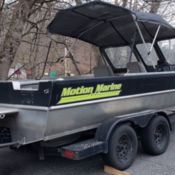

I would suggest that an impact with the thinner hull would probably result in roughly the same amount of damage to the thicker one also. We're almost cutting hairs on the difference. 190 and imagine the difference in protection that the thicker hull may give you. But I will state the following, visually compare. I propose you talk to your jet supplier for advice. It is quite normal to have hull modifications upstream of the jet intake that allows the jet intake to be slightly deeper submerged. Typically if the jet gets more than 10 air (by mass) then it will loss efficiency very fast.
#Inboard jet boats skin#
Heavier hulls may require more horsepower and I could "argue" that some builders don't offer a "lighter" skin and it's advantages. For low trim angles a lot of air gets entrained into the jet. and a 20ft jet boat will run between 2200lbs. Formula Vees can option in yet thicker alum. On an average, a 16ft jet boat will weight around 1600 lbs., an 18ft jet boat will weigh 2000 lbs. What are the best jet boats Currently, some of the most widely-known builders of jet boats include Yamaha Boats, Scarab, Chaparral, Sea-Doo and Williams Jet Tenders.
#Inboard jet boats professional#
160 hulls on the 18' but the 20 and 22's have. Boat Trader currently has 2,103 jet boats for sale, including 1,221 new vessels and 882 used boats, listed by individuals and professional boat and yacht dealers nationwide.

Weight, cost and perhaps a false sense of security. No one will disagree that a thicker hull will give you more protection when it comes to punctures however, there may be a downside to thicker aluminum. Well, not to one who disagree Capn Mike BUT, I think you should visit Alumawelds web page and review which models do or don't have "thick" skin. Expect other builders to be "not cheap"!!! Alumaweld builds more of this type of welded hull than ALL the other builders combined!!! Top Shelf!!!!Also look at NorthWest Jet Boats, Weldcraft, Woolridge, Duckworth. And boats in the 22' range are not cheap!! As an example, you should check out Alumawelds web page. You will not have an inboard/prop set-up (like a tourniment ski boat)but an inboard jet (nothing "hanging" under the bottom). Many hulls will start out at say 30 degrees at the bow and slowly flatten out to 10 degrees only at the last 4 or 5 feet of the hull. You do not have to run Wide Open Throttle to "get" to the 10 area, which is often just at the rear of other boats. For the explorer, hunter or prospector, this vessel will get you to where you want to go. This means you have the shallow water "run-ability" and 10 degree benifits at a slower speed. Designed with a shallow vee, delta pad and extra wide bottom, this boat can pack a load and navigate through some of the toughest river bed terrain. Let's say you get a 10 degree bottom on the model you choose, It will actually be 10 degrees from the area near the windshield all the way to the transom. One feature that Alumawelds have that other alum. 2006 Nw Jet Boats 21 Lightning Jet 2006 NW Jet Boats 21 Lightning Jet, Chevy 6. Then you can pick (for example) outboard jet power,regular outboard prop, Sport-jet power, inboard jet in V6 or V8 with different jets units,sterndrive. Flat bottom, 6,10,14 and 18 degree bottoms depending on the models you may choose. They make various hulls with many different degree hull angles.

My suggestion is to look at (for example) Alumaweld Boats.


 0 kommentar(er)
0 kommentar(er)
